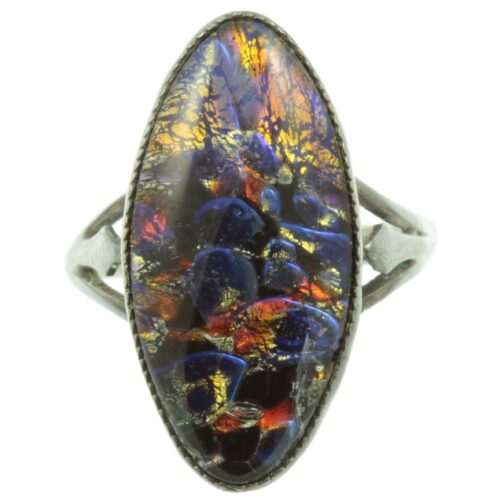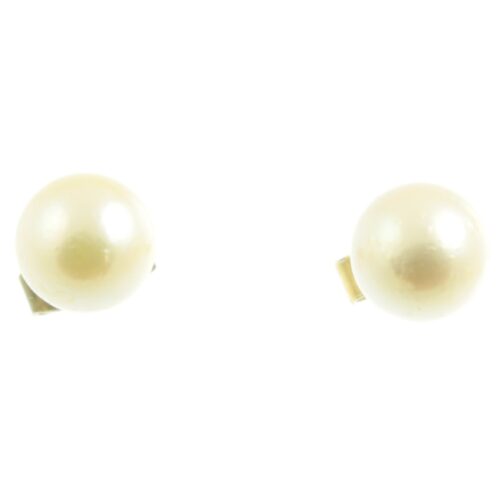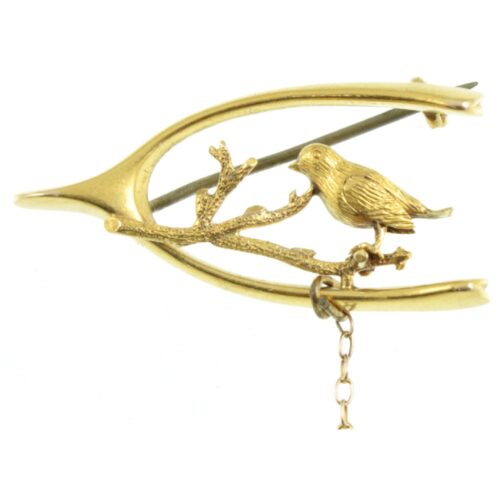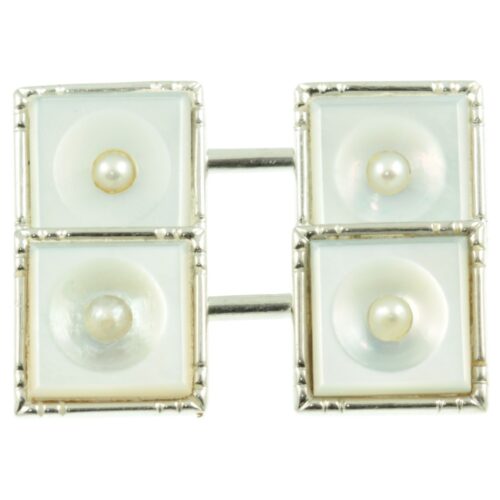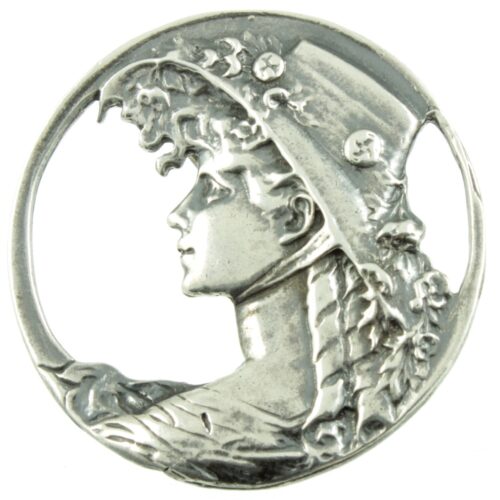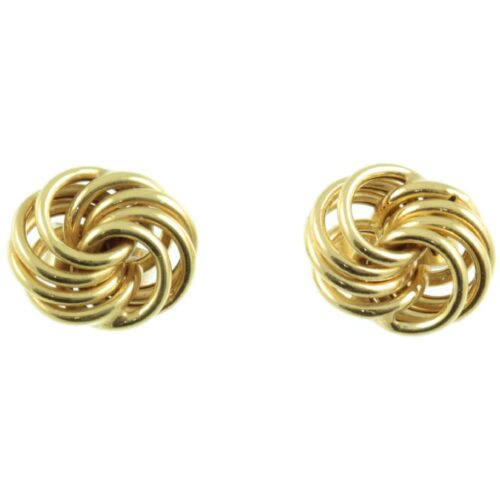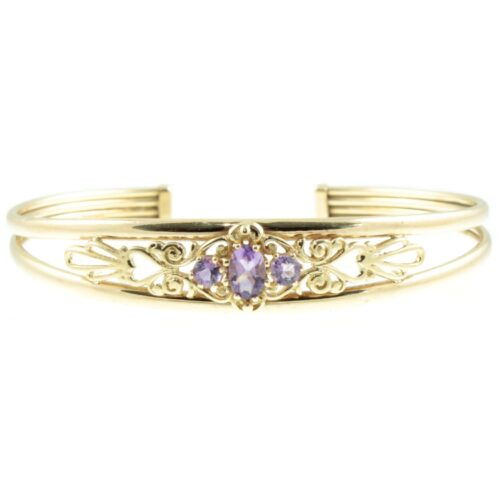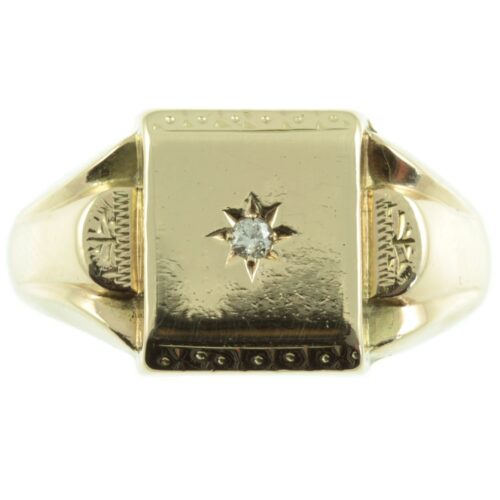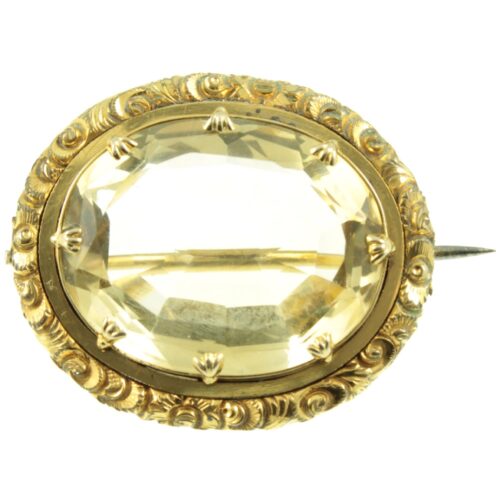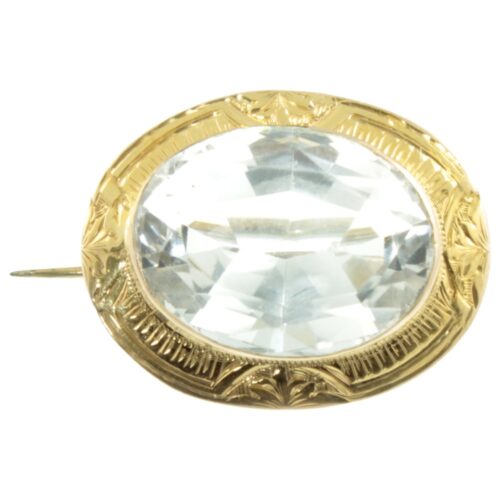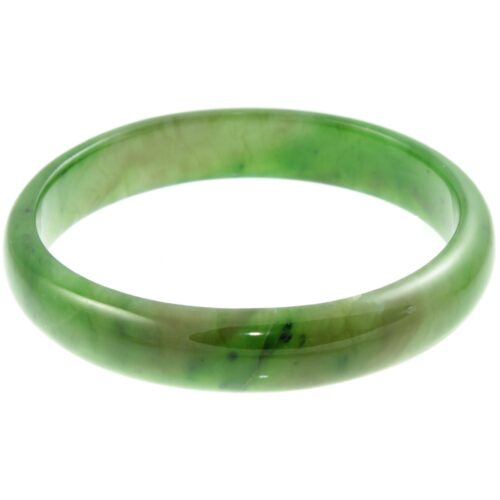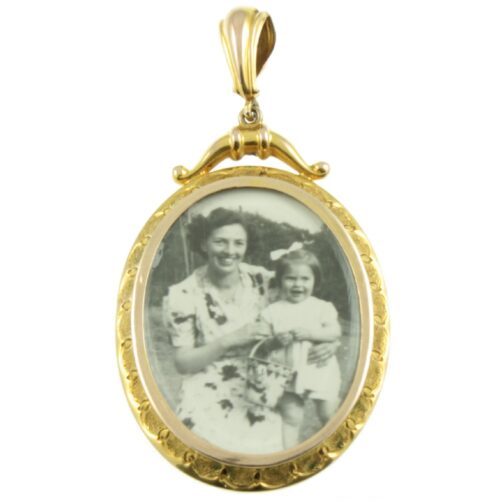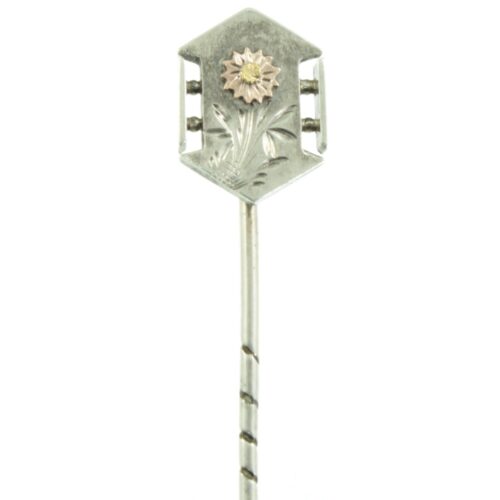-
A magical Art Deco Harlequin glass ring. A marquise-shaped harlequin art glass cabochon has been set in sterling silver and finished with a milgrain border. Manufactured by Thomas L. Mott, circa 1920s. Ring size: H, US: 4, top section size: 10mm x 21mm, weight: 3.4g. Period: Art Deco Jewellery ( 1920 – 1935 ).
-
A petite pair of stud pearl earrings. A pair of well-matched cultured pearls each with a creamy lustre, have been fixed to gold plated posts. A lovely pair of 1940s stud earrings, that are very wearable for everyday use. Pearl size: 6mm, weight: 1g. Period: Retro Jewellery ( the 1940s ).
-
A 1950s George Jensen tie clip. Manufactured in Denmark from sterling silver, this tie clip depicts the head of a stylised horse. It was designed by Arno Malinowski who worked for the Georg Jensen Company from 1936 to 1944 and again from 1949 to 1965. A well made vintage tie clip. Size : 18mm x 55mm, weight: 10g. Period: Mid-Century Jewellery (the 1950s).
-
A precisely engineered pair of Art Deco cufflinks. The central panels are made from 9ct yellow gold and have been engine turned to produce a knurled finish. These panels are surrounded by decorative silver borders, which creates a subtle contrast. These double-sided cufflinks are connected with cable link chains. A classic pair of engine-turned cufflinks, circa 1930s. Size: 13mm x 13mm, weight: 5g. Period: Art Deco Jewellery ( 1920 – 1935 ).
-
A Victorian Etruscan revival diamond tie pin. An old cut diamond weighing five points has been mounted in beautiful 15ct yellow gold and is surrounded by six gold spheres set to form eccentric circles with a twisted rope edge finish. This bright and lively diamond catches the light beautifully. All of our tie pins are sold with a stopper fitted to the point. Size: 7mm x 62mm, weight: 1.8g. Period: Victorian Jewellery ( 1837 – 1901 ).
-
A meticulously crafted Art Nouveau bird brooch. Made from rich 15ct yellow gold, a small bird is perched on a branch is framed inside a wishbone. This brooch is fitted with a safety chain and contains hallmarks for 1890. A unique and well-made piece of fine jewellery. Size: 17mm x 34mm, safety chain: 68mm, weight: 2.9g. Period: Art Nouveau Jewellery ( 1890 – 1901 ).
-
An elegant pair of Art Deco cufflinks. A seed pearl has been placed in a hollow at the center of a bevelled edged piece of mother of pearl. Which is set in a backing of 9ct white gold. These double-sided cufflinks are connected with a single fetter link. Add a touch of sophistication to your attire with these timeless cufflinks. Size: 10mm x 10mm, weight: 2.3g each. Period: Art Deco Jewellery ( 1920 – 1935 ).
-
A classic Victorian Etruscan revival tie pin. Made from rich 15ct yellow gold, this tie pin features an old cut diamond at the center a star setting, with a rope border and an outer ring of eight flowers. This exquisite tie pin comes in its original box. All of our tie pins are sold with a stopper fitted to the point. Size: 9mm x 50mm, weight: 1.3g. Period: Victorian Jewellery ( 1837 – 1901 ).
-
An impressive Art Nouveau sterling silver brooch. This hand-made brooch depicts the profile of a young woman wearing a flamboyant hat, decorated with roses and foliage. The safety pin to the rear has been mounted at an angle that allows an uninterrupted view. A lovely brooch that is very representative of its period. Circa 1900. Size: 41mm in diameter, weight: 13g. Period: Art Nouveau Jewellery ( 1890 – 1901 ).
-
A beautiful pair of 9ct gold earrings. Eight gold bands interlock together to form a swirling design. An elegant and understated pair of stud earrings. Size: 9mm in diameter, total weight: 0.8g. Period: Modern Jewellery ( the 1960s onwards ).
-
An ornate Amethyst torque bangle. A central oval cut amethyst has been set in 9ct yellow gold, with round cut amethyst gemstones to either side. These bright and lively gemstones which have a combined weight of 56 points are raised above an Art Nouveau style decorative panel. A very pretty vintage torque bangle. Size: 57mm inside diameter, decorative panel: 11mm x 42mm, weight: 6.8g. Period: Modern Jewellery ( the 1960s onwards ).
-
A distinguished Edwardian signet ring. Made from 9ct gold this ring features an old cut diamond, which been mounted in a star setting at the center of a square panel. Along with decorative detailing to the sides and shoulders. This impressive ring was manufactured by Henry Griffith & Sons Ltd and is hallmarked for the year 1904. Total Diamond Weight: 5 points. Ring size: UK size Z, US size 12.5, top section: 19mm x 14mm, weight 13.5g, This ring can be re-sized free of charge, upon request. Period: Edwardian Jewellery ( 1901 to 1914 ).
-
A bright Victorian pinchbeck Citrine Brooch. An oval cut Citrine gemstone weighing 25ct has been set in pinchbeck. Pinchbeck is an alloy of copper and zinc and was invented in the 18th Century to resemble gold. This large Citrine has excellent colour saturation and clarity, allowing it to catch the light beautifully. Size: 32mm x 28mm, weight:11.6g. Period: Victorian ( 1837 – 1901 ).
-
A flawless Victorian Goshenite brooch. An oval cut Goshenite gemstone weighing 22.80ct has been set in 9ct yellow gold. Goshenite or white beryl as it is sometimes called is said to be the purest of all the gemstones due to its incredible transparency. Although it appears completely transparent, there is a very slight blue/green hue visible when viewed from an angle. A bright and lively brooch, which looks amazing when worn. Size: 30mm x 23mm, weight: 7.6g. Period: Victorian ( 1837 – 1901 ).
-
A timeless 1940s Chinese Jade bangle. This highly polished Jade bangle was hand-carved and evidence of this is in the tiny discrepancies ( known as tool-marks ) which can be felt but not seen on its outer circumference. Showcasing the jewellers high level of skill and craftsmanship. A very stylish piece of retro jewellery. Inside diameter: 64mm, Outside diameter: 75, Width: 13mm, Weight: 44.7g. Period: Retro Jewellery ( the 1940s ).
-
A skillfully carved cameo pendant. Made from lava stone, this beautiful cameo depicts a lady in profile with foliate hair decoration. It is mounted in a 9ct gold frame and suspended from a 9ct gold flat cable link chain, measuring 22" / 56mm in length. The bail on this cameo is hallmarked "star 1 AR", which stands for manufactured by UnoAErre in the Arezzo area of Italy pre-1934. A fine example of Italian craftsmanship. Pendant size: 35mm x 23mm. Chain length: 56cm (22″), weight 8.1g. Period: Art Deco Jewellery ( 1920 – 1935 ).
-
A lovely 1940s picture locket. Made from 9ct yellow gold, this oval-shaped locket features a decorative border and a scroll motif. The center of the locket can be removed entirely, with the photos been placed between two pieces of glass. A very pretty retro locket. Size: 52mm x 27mm, weight 7.1g. Period: Retro Jewellery ( the 1940s ).
-
A classic Victorian 15ct gold mourning ring. A nonagon-shaped ring, with a central plaque, flanked on either side by foliate motifs. The band contains intricately plated strands of hair placed inside the central channel. These are end times pieces of jewellery commemorating the death of a loved one. A beautiful and unique mourning ring. Ring Size: N, US 6.75, weight: 1.8g Due to its design, this ring is unsuitable for resizing. Period: Victorian ( 1837 – 1901 ).
-
An elegant 9ct yellow gold Edwardian tie pin. Depicting flowers in raised relief polished gold, which has been set against a textured gold background creating a beautiful contrast. This item is hallmarked for 1909, it also bears the markers mark: Swain Bros. An eye-catching piece of fine jewellery. All of our tie pins are sold with a stopper fitted to the point. Size: 48mm x 8mm, weight: 0.8g. Period: Edwardian Jewellery ( 1901 – 1914 ).
-
A precisely crafted Art Nouveau tie pin, depicting a flower. The flower head is raised and made from rose and yellow gold, which creates a subtle contrast. An original piece with a beautifully aged patina. All of our tie pins are sold with a stopper fitted to the point. Size: 61mm x 11mm, weight: 1.7g. Period: Art Nouveau Jewellery ( 1890 – 1901 ).

